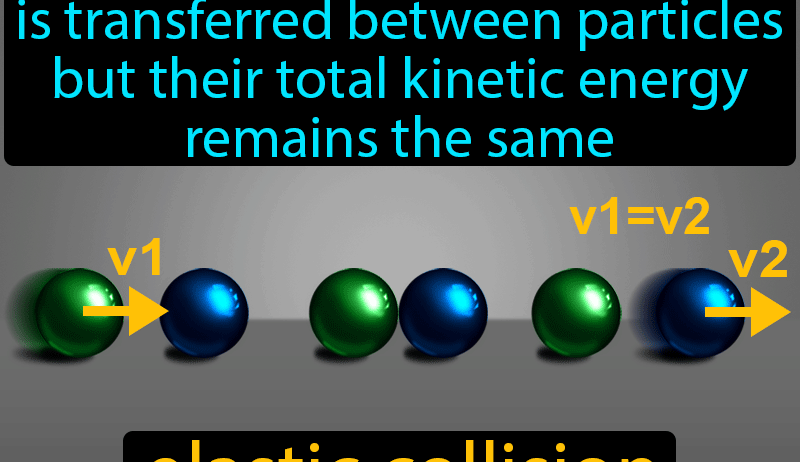Have you ever wondered why balls bounce? Is there a hidden science behind that delightful rebound? Welcome to the world of elastic collisions—a fascinating phenomenon that preserves kinetic energy in a way that enchants and intrigues. This principle is pivotal in numerous domains, from sports to astrophysics, showcasing the magic of conservation in action.
In the simplest terms, an elastic collision occurs when two objects collide without any loss of kinetic energy. Unlike inelastic collisions, where some energy is transformed into other forms, elastic collisions maintain the total energy in the system. This vibrant interaction presents a myriad of challenges and questions worth exploring. What exactly happens during these collisions? How does energy conservation play a vital role? Let’s embark on this scientific inquiry, navigating through the core principles and examples of elastic collisions.
Before delving deeper, it is essential to understand the fundamental concepts of energy. Energy can be defined as the capacity to do work, and in the context of motion, we often refer to kinetic energy—the energy an object possesses due to its movement. The formula for kinetic energy is KE = 1/2 mv², where m is the mass of the object and v is its velocity. During an elastic collision, the sum of the kinetic energies of the colliding objects remains unchanged before and after the collision. This principle embodies conservation of energy, highlighting one of the core tenets of physics.
To visualize this concept, consider a classic scenario in physics: two billiard balls colliding on a pool table. Before the collision, each ball has its distinct velocity and kinetic energy. Once they collide, they exchange energy and momentum, yet the total kinetic energies of both balls are conserved. The balls bounce off each other and move in separate directions. Depending on their masses and velocities, they can continue moving with their kinetic energies intact, reflecting the resilience of energy conservation in elastic collisions.
Let’s break down the mechanics further. During the collision, forces are exerted between the two objects. These forces act for a very short time, leading to a change in momentum. The impulse experienced by each ball is equal and opposite, according to Newton’s third law. Mathematically, this can be captured by the equations governing momentum conservation: m₁v₁ + m₂v₂ = m₁v₁’ + m₂v₂’, where prime (’ symbol) represents the post-collision velocities. By manipulating these equations, we can predict the velocities of objects after the collision, showcasing the beautifully predictable nature of physics.
In the realm of sports, elastic collisions manifest vividly. When a basketball strikes the floor, it deforms and then returns to its original shape, bouncing back. This is due to the elastic nature of the materials involved, which retain the energies within the system. Athletes leverage this understanding to enhance their performance, utilizing the principles of energy conservation to optimize their movements. Coaches and athletes alike marvel at how efficiently they can harness these physical properties.
The implications of elastic collisions extend beyond sports and into the cosmos. Take, for example, celestial bodies that collide in space. When asteroids or comets impact each other, they sometimes exhibit elastic collision characteristics, depending on their composition and relative velocities. This fundamental interaction does not only shape the formation of planetary bodies but also informs our understanding of cosmic evolution and the dynamics of celestial mechanics.
So, how do we encounter challenges in understanding these principles? On a macroscopic scale, real-world conditions complicate the pureness of elastic collisions. Friction, deformation, and thermal energy loss often shift the scene toward inelastic collisions. Observing purely elastic collisions requires controlled environments. Researchers utilize high-speed cameras and sophisticated apparatuses to isolate these interactions, providing clearer insight into the underlying physics.
Moreover, the playful question remains: Can we exploit elastic collisions to address pressing global challenges, such as climate change? Imagine if we could apply energy conservation principles to develop more efficient transportation systems, minimizing wasted energy in motion. The potential exists to innovate solutions rooted in physics, leveraging understanding to design eco-friendly technologies that utilize the mechanics of elastic collisions in new, inventive ways. The implications extend beyond amusement and into real-world application, illustrating the promise of scientific inquiry.
As we navigate further, it becomes clear that the study of elastic collisions not only entertains our curiosity but equips us with the language of the universe. It imparts insights that transcend conventional utility, urging us to contemplate the interconnectedness of energy, movement, and sustainability.
In conclusion, elastic collisions epitomize the remarkable capacity of energy conservation in action, illustrating a dynamic interplay of forces that govern both the mundane and the spectacular. By exploring the principles at work during these interactions, we enhance our understanding of both fundamental physics and its vast potential applications in a world grappling with energy challenges. As we ponder the questions and challenges posed by this scientific adventure, it becomes evident that the bounce-back effect may hold keys to a more sustainable and energy-conscious future.








